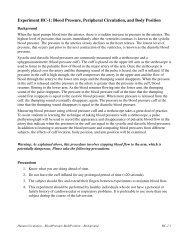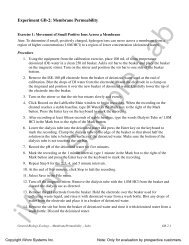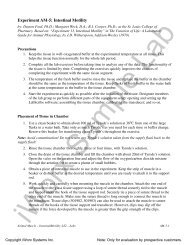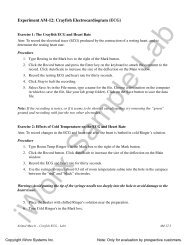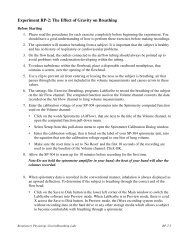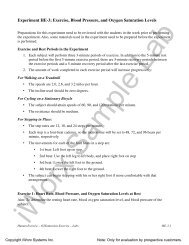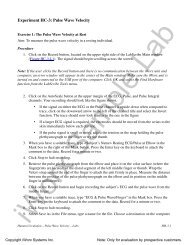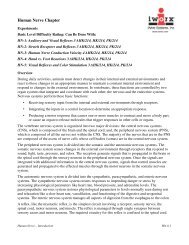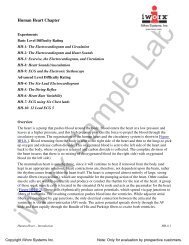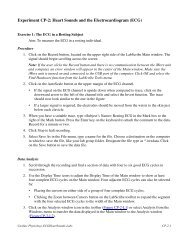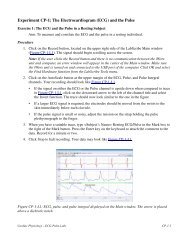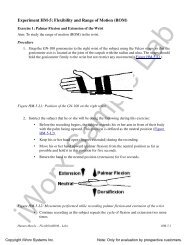Personality and Vagal Tone - iWorx
Personality and Vagal Tone - iWorx
Personality and Vagal Tone - iWorx
You also want an ePaper? Increase the reach of your titles
YUMPU automatically turns print PDFs into web optimized ePapers that Google loves.
Experiment HP-5: Heart Rate, Blood Pressure, <strong>and</strong> <strong>Vagal</strong> <strong>Tone</strong><strong>Personality</strong> <strong>and</strong> <strong>Vagal</strong> <strong>Tone</strong> SectionNote: If you choose to do Heart Rate, BP, <strong>Vagal</strong> <strong>Tone</strong> or Vigilance-Reaction Time experiments – choosethose labs from the Human Psychophysiology section.Exercise 1: <strong>Personality</strong> <strong>and</strong> <strong>Vagal</strong> <strong>Tone</strong>Aim: To test a hypothesis that persons with high perceived shyness <strong>and</strong> behavioral inhibition havelower <strong>Vagal</strong> tone than persons with low perceived shyness. <strong>Vagal</strong> tone is measured as the differencebetween the maximum <strong>and</strong> minimum heart rates of the subject during normal breathing.Procedure1. Instruct the subject to sit quietly <strong>and</strong> breathe normally before <strong>and</strong> during the recordings toprevent the creation of motion artifacts. The subject should sit erect so that the musclesinvolved in pulmonary ventilation are able to move without restriction.Warning: Stop the experiment if the subject feels dizzy or nauseated.2. Type Normal Breathing in the Mark box to the right of the Mark button.3. Click Record. Press the Enter key on the keyboard. Click AutoScale for all four channels.Record the subject’s breathing <strong>and</strong> heart rates for at least one minute.4. Click Stop to halt recording.5. Select Save in the File menu.Data Analysis1. Scroll through the data file <strong>and</strong> find the recording of the subject’s heart <strong>and</strong> breathing rateswhile breathing normally.2. Use the same techniques explained in the Heart Rate-BP section of the lab to adjust the DisplayTime of the Main window to show an artifact-free section of data containing five breath cyclesin the Main window.3. Click on the Analysis window icon in the toolbar or select Analysis from the Windows menu totransfer the data displayed in the Main window to the Analysis window (Figure HP-5-L1).4. On the Respiration channel, click <strong>and</strong> drag one cursor to the beginning of the first breath cycledisplayed in the Analysis window (Figure HP-5-L1). Drag the other cursor to the beginning ofthe second breath cycle <strong>and</strong> measure the following:• Maximum Heart Rate. The value for Max on the Heart Rate channel is the subject’smaximum heart rate during the first breath cycle.• Minimum Heart Rate. The value for Min on the Heart Rate channel is the subject’sminimum heart rate during the first breath cycle.<strong>iWorx</strong> Sample LabHuman Psychophysiology – <strong>Personality</strong> & <strong>Vagal</strong> <strong>Tone</strong> – LabsHP-5-1Copyright <strong>iWorx</strong> Systems Inc.Note: Only for evaluation by prospective customers.
• Mean Heart Rate. The value for Mean on the Heart Rate channel is the subject’s meanheart rate during the first breath cycle.Figure HP-5-L1: The pulse wave, respiration, heart rate, <strong>and</strong> breathing rate recordings of a subjectusing abdominal breathing while at rest are displayed, from top to bottom, in the Analysis window. Onthe respiration channel, inhalation is displayed as an upsweep. Notice that the heart rate goes upduring inhalation.5. Record the values for these rates in the Journal using one of the techniques described in theHeart Rate-BP section of this lab, <strong>and</strong> in Table HP-5-L1.6. On the Respiration channel, leave one cursor at the beginning of the second breath cycle. Click<strong>and</strong> drag the other cursor to the beginning of the third breath cycle displayed in the Analysiswindow.7. Repeat Steps 4 <strong>and</strong> 5 for the second breath cycle.8. Move the cursors to the beginning <strong>and</strong> end of each of the three remaining breath cycles <strong>and</strong>repeat Steps 4 <strong>and</strong> 5 for each breath cycle9. Determine the means of the maximum <strong>and</strong> the minimum heart rates for the five breaths. Enterthese values in Table HP-5-L1.<strong>iWorx</strong> Sample LabHuman Psychophysiology – <strong>Personality</strong> & <strong>Vagal</strong> <strong>Tone</strong> – LabsHP-5-2Copyright <strong>iWorx</strong> Systems Inc.Note: Only for evaluation by prospective customers.
Table HP-5-L1: Heart Rate Variation during Normal BreathingHeart Rate (BPM)Subject Max Min ∆Breath 1Breath 2Breath 3Breath 4Breath 5MeanBreath Rate (BrPM)10. Determine the difference (∆) between the mean maximum <strong>and</strong> mean minimum heart rates <strong>and</strong>enter this value in Table HP-5-L1. This difference, which will be used to measure <strong>Vagal</strong> tone, isalso known as the respiratory sinus arrhythmia (RSA) prominence.11. On the Respiration channel, click <strong>and</strong> drag one cursor to the beginning of the first breath cycle.Click <strong>and</strong> drag the other cursor to the end of the fifth breath cycle displayed in the Analysiswindow <strong>and</strong> measure the Mean Breath Rate. The value for Mean on the Breath Rate channel isthe subject’s mean breath rate over the five consecutive breath cycles.12. Record the value for this rate in the Journal using one of the techniques described in Exercise 1,<strong>and</strong> in the data table.13. Have the subject answer the questions in the shyness/behavioral inhibition questionnaire inTable HP-5-L2.Questions1. What is the value for the <strong>Vagal</strong> tone of the subject? What percentage of the mean minimumheart rate is the value for the <strong>Vagal</strong> tone?2. How does the <strong>Vagal</strong> tone of this subject compare to the subject’s score on theshyness/behavioral inhibition questionnaire?3. How does the <strong>Vagal</strong> tone of this subject compare to those of other subjects? When the <strong>Vagal</strong>tones <strong>and</strong> shyness scores of all the subjects are compared, is there a correlation betweenshyness/behavioral inhibition <strong>and</strong> <strong>Vagal</strong> tone?4. Does any other factor besides shyness or inhibition affect <strong>Vagal</strong> tone?<strong>iWorx</strong> Sample LabHuman Psychophysiology – <strong>Personality</strong> & <strong>Vagal</strong> <strong>Tone</strong> – LabsHP-5-3Copyright <strong>iWorx</strong> Systems Inc.Note: Only for evaluation by prospective customers.
Table HP-5-L2: Shyness/Behavioral Inhibition Questionnaire*QuestionHow often do you experience awkwardness or discomfort in the following situations? Score (0-4)1. At a party2. On a dinner date3. In a class discussion when expected to contribute.4. In a uncrowded elevator.5. When introduced to someone.6. In a study group.7. When asked to introduce yourself in class.8. When asking someone out for coffee (tea, soda, etc.)9. When asking for notes from a classmate after an absence.10. When speaking to a professor.How often do you have difficulty actually doing (taking action on) the following? Score (0-4)11. Making <strong>and</strong> sustaining eye contact in a conversation.12. Initiating a conversation with persons you do not know well.13. Disagreeing with someone.14. Asking a question in class.15. Making small talk.16. Asking directions or help.17. Calling people on the phone to invite them over.18. Giving aide or attention to someone in distress.19. Seeking information from others about class assignments.20. Telling someone he or she is bothering you.TOTAL* Ratings: 0=never, 1=rarely, 2=occasionally, 3=often, 4=almost always. The total score is the sum ofthe ratings for all 20 questions<strong>iWorx</strong> Sample LabHuman Psychophysiology – <strong>Personality</strong> & <strong>Vagal</strong> <strong>Tone</strong> – LabsHP-5-4Copyright <strong>iWorx</strong> Systems Inc.Note: Only for evaluation by prospective customers.
ReferencesCole, P. M., Zahn-Waxler, C., Fox, N. A., Usher, B. A., & Welsh, J. D. (1996). Individual Differences inEmotion Regulation <strong>and</strong> Behavior Problems in Preschool children. Journal of Abnormal Psychology,105(4), 518-529.Eisenberg, N., Fabes, R. A., Karbon, M., Murphy, B. C., Carlo, G., & Wosinski, M. (1996). Relationsof School Children’s Comforting Behavior to Empathy-related Reactions <strong>and</strong> Shyness. SocialDevelopment, 5(3), 330-351.Harris, R. M., Porges, S. W., Carpenter, M. E., & Vincenz, L. M. (1993). Hypnotic Susceptibility, MoodState, <strong>and</strong> Cardiovascular Reactivity. American Journal of Clinical Hypnosis, 36(1), 15-25.Jemerin, J. M. & Boyce, W. T. (1990). Psychobiological Differences in Childhood Stress Response. II.Cardiovascular Markers of Vulnerability. Journal of Developmental Behavioral Pediatrics, 11(3), 140-150.Kagan, J., Reznick, J. S., & Snidman, N. (1987). The Physiology <strong>and</strong> Psychology of BehavioralInhibition in Children. Child Development, 58, 1459-1473.Lane, J. D., Adcock, R. A., & Burnett, R. E. (1992). Respiratory Sinus Arrhythmia <strong>and</strong> CardiovascularResponses to Stress. Psychophysiology, 29(4), 461-470.Porges, S. W. (1992). <strong>Vagal</strong> tone: A Physiological Marker of Stress Vulnerability. Pediatrics, 90(3),498-504.Thayer, J. F., Friedman, B. H. & Borkovec, T. D. (1996). Autonomic Characteristics of GeneralizedAnxiety Disorder <strong>and</strong> Worry. Biological Psychiatry, 39(4), 255-266.<strong>iWorx</strong> Sample LabHuman Psychophysiology – <strong>Personality</strong> & <strong>Vagal</strong> <strong>Tone</strong> – LabsHP-5-5Copyright <strong>iWorx</strong> Systems Inc.Note: Only for evaluation by prospective customers.



